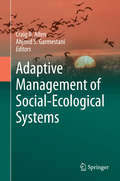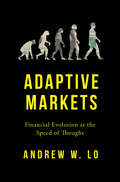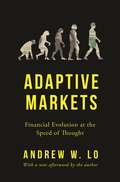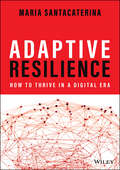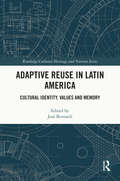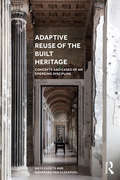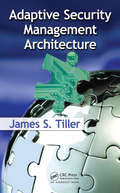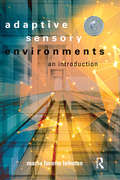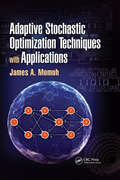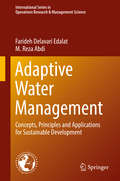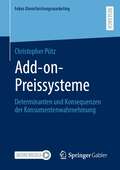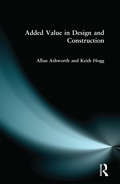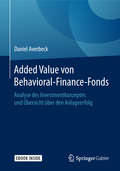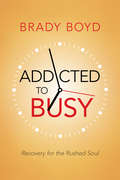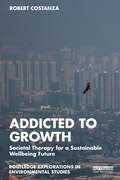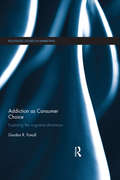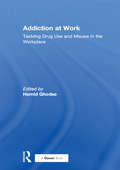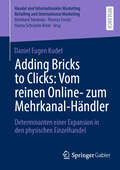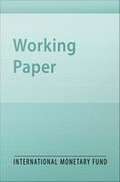- Table View
- List View
Adaptive Management of Social-Ecological Systems
by Craig R. Allen Ahjond S. GarmestaniAdaptive management is an approach to managing social-ecological systems that fosters learning about the systems being managed and remains at the forefront of environmental management nearly 40 years after its original conception. Adaptive management persists because it allows action despite uncertainty, and uncertainty is reduced when learning occurs during the management process. Often termed "learning by doing", the allure of this management approach has entrenched the concept widely in agency direction and statutory mandates across the globe. This exceptional volume is a collection of essays on the past, present and future of adaptive management written by prominent authors with long experience in developing, implementing, and assessing adaptive management. Moving forward, the book provides policymakers, managers and scientists a powerful tool for managing for resilience in the face of uncertainty.
Adaptive Markets: Financial Evolution at the Speed of Thought
by Andrew W. LoA new, evolutionary explanation of markets and investor behaviorHalf of all Americans have money in the stock market, yet economists can't agree on whether investors and markets are rational and efficient, as modern financial theory assumes, or irrational and inefficient, as behavioral economists believe—and as financial bubbles, crashes, and crises suggest. This is one of the biggest debates in economics and the value or futility of investment management and financial regulation hang on the outcome. In this groundbreaking book, Andrew Lo cuts through this debate with a new framework, the Adaptive Markets Hypothesis, in which rationality and irrationality coexist. Drawing on psychology, evolutionary biology, neuroscience, artificial intelligence, and other fields, Adaptive Markets shows that the theory of market efficiency isn't wrong but merely incomplete. When markets are unstable, investors react instinctively, creating inefficiencies for others to exploit. Lo's new paradigm explains how financial evolution shapes behavior and markets at the speed of thought—a fact revealed by swings between stability and crisis, profit and loss, and innovation and regulation.A fascinating intellectual journey filled with compelling stories, Adaptive Markets starts with the origins of market efficiency and its failures, turns to the foundations of investor behavior, and concludes with practical implications—including how hedge funds have become the Galápagos Islands of finance, what really happened in the 2008 meltdown, and how we might avoid future crises. An ambitious new answer to fundamental questions in economics, Adaptive Markets is essential reading for anyone who wants to know how markets really work.
Adaptive Markets: Financial Evolution at the Speed of Thought
by Andrew W. LoA new, evolutionary explanation of markets and investor behaviorHalf of all Americans have money in the stock market, yet economists can’t agree on whether investors and markets are rational and efficient, as modern financial theory assumes, or irrational and inefficient, as behavioral economists believe. The debate is one of the biggest in economics, and the value or futility of investment management and financial regulation hangs on the answer. In this groundbreaking book, Andrew Lo transforms the debate with a powerful new framework in which rationality and irrationality coexist—the Adaptive Markets Hypothesis. Drawing on psychology, evolutionary biology, neuroscience, artificial intelligence, and other fields, Adaptive Markets shows that the theory of market efficiency is incomplete. When markets are unstable, investors react instinctively, creating inefficiencies for others to exploit. Lo’s new paradigm explains how financial evolution shapes behavior and markets at the speed of thought—a fact revealed by swings between stability and crisis, profit and loss, and innovation and regulation. An ambitious new answer to fundamental questions about economics and investing, Adaptive Markets is essential reading for anyone who wants to understand how markets really work.
Adaptive Platform Trials: The Clinical Trial of the Future?
by Ariel D. Stern Sarah MehtaIn July 2017, Dr. Brian M. Alexander, president and CEO of the AGILE Research Foundation, was preparing to launch a new type of clinical trial-an adaptive platform trial-to study potential therapies for glioblastoma (GBM), an aggressive form of brain cancer. Alexander believed that the standard way in which new cancer drugs were tested-the traditional randomized controlled trial (RCT)-was limited in many ways. While statistically rigorous and still considered the "gold standard" in clinical research, traditional RCTs were time-consuming, costly, and limited to testing just one new drug at a time. Adaptive platform trials, by contrast, facilitated simultaneously studying multiple therapies for a given disease and promised a number of efficiency improvements. They also used statistical techniques to allow more patients to access promising therapies. As such, they had the potential to fundamentally change the clinical research process, making clinical trials for new cancer drugs more efficient, more accessible to patients, and more ambitious in scope. For the past three years, Alexander had been working closely with a group of like-minded oncologists, statisticians, and clinical trial strategists to design an adaptive platform trial for GBM in the hopes of identifying effective therapies more quickly. By mid-2017, Alexander and his colleagues had completed a master protocol for the trial. But now the research team faced several design and operational challenges as they prepared for the trial's launch. Most pressing, how should Alexander and his colleagues finance the trial?
Adaptive Platform Trials: The Clinical Trial of the Future? (B)
by Ariel D. Stern Sarah MehtaThis case provides an update to the (A) case, which introduces students to adaptive platform trials, an ambitious, more efficient type of clinical trial that increases access to therapies. The A case centers on Dr. Brian Alexander's efforts to launch an adaptive platform trial for studying potential therapies for glioblastoma (GBM), an aggressive form of brain cancer. The (B) case provides an update and explores the strategies that Alexander is considering for sustainably financing this trial.
Adaptive Platform Trials: The Clinical Trial of the Future? (C)
by Ariel D. Stern Sarah MehtaThis (C) case provides an update on the work of the Global Coalition for Adaptive Research (GCAR) and also illustrates how adaptive platform trials can nimbly respond to a global pandemic.
Adaptive Resilience: How to Thrive in a Digital Era
by Maria SantacaterinaBig-picture business transformation with specific game-changing strategies In Adaptive Resilience, Global Strategic Leader, Board Executive Advisor, Speaker and renowned Author Maria Santacaterina delivers a groundbreaking discussion of how to build a more inclusive, equitable and sustainable digital future by transforming your organisation from the inside-out and the outside-in. You’ll discover how to create a virtuous cycle of growth to simultaneously increase the bottom-line and help your Enterprise evolve. The author’s new paradigm for growth is a radical shift in the way we think and do “good” business. It helps Business Leaders re-imagine the Enterprise and steer new frontier technologies in the right direction. You’ll learn how to create adaptability and build resilience in your Enterprise, encourage visionary leadership and effective oversight. You’ll find: Real-life case studies that highlight the concepts discussed within Strategies for developing dynamic capabilities to power your organisation forward Valuable insights based on multidisciplinary research at the intersection of innovation, technology and sustainability A can’t-miss guide to help reinvent the Enterprise that belongs on the shelves of Board Directors, CEOs, Senior Executives and Business Leaders, Adaptive Resilience is the strategy blueprint to modern business that we’ve all been waiting for.
Adaptive Reuse in Latin America: Cultural Identity, Values and Memory (Routledge Cultural Heritage and Tourism Series)
by José BernardiThis book seeks to explore the theoretical and architectural connections between memory, values, cultural identity, and adaptive reuse in Latin America. It does so by critically analyzing ideas and works within the context from where they emerge. With rich and layered historic centers, a wealth of colonial and 19th-century buildings, and the heritage from the modern era, Latin America offers a unique architectural patrimony and its contribution and impact on contemporary culture and architecture still require critical study and discussion. The chapters of this timely book consider the conflicted relationship between colonialism, native cultures, and immigration. It also explores the connections between modern projects and national identity, and contemporary interventions serving the needs of diverse societies while being cultural receptacles of memory. While most books on adaptive reuse focus on the larger general concepts, different technical approaches, and case studies, this book will contribute to the study of adaptive reuse moving away from Europe and North America, focusing instead on cases in Brazil, Mexico, Argentina, Ecuador, and Peru. This book is an important resource for researchers and students in the area of architecture, cultural, global, and design studies, heritage, geography, sociology, and history.
Adaptive Reuse of the Built Heritage: Concepts and Cases of an Emerging Discipline
by Bie Plevoets Koenraad Van CleempoelAdaptive reuse – the process of repairing and restoring existing buildings for new or continued use – is becoming an essential part of architectural practice. As mounting demographic, economic, and ecological challenges limit opportunities for new construction, architects increasingly focus on transforming and adapting existing buildings. This book introduces adaptive reuse as a new discipline. It provides students and professionals with the understanding and the tools they need to develop innovative and creative approaches, helping them to rethink and redesign existing buildings – a skill which is becoming more and more important. Part I outlines the history of adaptive reuse and explains the concepts and methods that lie behind new design processes and contemporary practice. Part II consists of a wide range of case studies, representing different time periods and strategies for intervention. Iconic adaptive reuse projects such as the Caixa Forum in Madrid and the Rijksmuseum in Amsterdam are discussed alongside less famous and spontaneous transformations such as the Kunsthaus Tacheles in Berlin, in addition to projects from Italy, Spain, Croatia, Belgium, Poland, and the USA. Featuring over 100 high-quality color illustrations, Adaptive Reuse of the Built Heritage is essential reading for students and professionals in architecture, interior design, heritage conservation, and urban planning.
Adaptive Security Management Architecture
by James S. TillerThis volume enables security professionals to structure the best security program designed to meet the complex needs of an entire organization, taking into account the organization's business goals as well as the surrounding controls, processes, and units already in existence. The book explains how an organization can develop an adaptive security program closely aligned to business needs, making it an enabling force that helps the organization achieve its goals and objectives. It presents the end product of a successful security management system and examines the finer points of how it can be accomplished.
Adaptive Sensory Environments: An Introduction
by Maria Lorena Lehman***WINNER OF A NAUTILUS 2017 SILVER MEDAL BOOK AWARD*** Adaptive Sensory Environments: An Introduction presents a cutting-edge methodology for adaptive sensory design by fostering an inter-disciplinary approach in which aspects of neuroscience, biophilia, captology, nanotechnology, kinetics, and sensemaking all play critical roles in helping adaptive architecture "tune" to occupants. Furthermore, the book illustrates how adaptive sensory environments transform and uplift quality of life in entirely new ways, by strategically unlocking the potential that technological innovations bring. By teaching scholars, researchers, practitioners, specialists, and consultants how to design architecture that guides what emerging interactive technology can do, it allows them to see deeper into an architectural design, to extend beyond interaction and, ultimately, to build environments that adapt by changing and growing with their occupants’ immediate needs and long-term goals.
Adaptive Stochastic Optimization Techniques with Applications
by James A. MomohAdaptive Stochastic Optimization Techniques with Applications provides a single, convenient source for state-of-the-art information on optimization techniques used to solve problems with adaptive, dynamic, and stochastic features. Presenting modern advances in static and dynamic optimization, decision analysis, intelligent systems, evolutionary pro
Adaptive Thermal Comfort of Indoor Environment for Residential Buildings: Efficient Strategy for Saving Energy (SpringerBriefs in Architectural Design and Technology)
by Carlos Rubio-Bellido David Bienvenido-HuertasThis book is structured in four parts: First, it analyzes the sustainability objectives established for the building stock and the importance of thermal comfort in this aspect. Second, the existing adaptive thermal comfort models and the main energy-saving measures associated with these models are analyzed. Third, the energy savings obtained with these measures are analyzed in several case studies, comparing the results obtained with other energy conservation measures, such as the improvement of the façade. The analysis is carried out from an energy and economic perspective. Finally, a decision‐making process based on fuzzy logic is established. As an expected result, the content of the book contributes to assist architects in designing more efficient buildings from the perspective of user behavior.
Adaptive Water Management: Concepts, Principles and Applications for Sustainable Development (International Series in Operations Research & Management Science #258)
by Farideh Delavari Edalat M. Reza AbdiThis book explores a new framework of Adaptive Water Management (AWM) for evaluating existing approaches in urban water management. It highlights the need to adopt multidisciplinary strategies in water management while providing an in-depth understanding of institutional interactions amongst different water related sectors. The key characteristics of AWM i. e. polycentric governance, organisational flexibility and public participation are investigated and described through a critical review of the relevant literature. The book presents an empirical case study undertaken in a selected developing-country city to investigate the potential gaps between the current water management approaches and possible implementation of AWM. Feasibility of AWM operations is examined in an environment surrounded by established water management structure with centralised governance and an institutional process based on technical flexibility. The key elements of AWM performance are (re)structured and transformed into decision support systems. Multi criteria decision models are developed to facilitate quantification and visualization of the elements derived from the case study, which is involved with water companies and water consumers. The book describes how the concept of AWM, along with structuring suitable decision support systems, can be developed and applied to developing-country cities. The book highlights the barriers for applying the AWM strategies that include established centralised decision making, bureaucratic interactions with external organisations, lack of organisational flexibility within the institutions, and lack of recognition of public role in water management. The findings outline that despite the lack of adaptability in the current water management in the case study, as an example of developing countries, there are positive attitudes among water professionals and the public towards adaptability through public-institutional participation. /p>
Adaptiveness: Finding Meaning in Apparent Noise
by Stephan H. HaeckelTo demonstrate the benefits of adopting a sense-and-respond business model in order to enable the organization to respond to a much broader spectrum of possible customer needs.
Add-on-Preissysteme: Determinanten und Konsequenzen der Konsumentenwahrnehmung (Fokus Dienstleistungsmarketing)
by Christopher PützChristopher Pütz untersucht in drei Forschungsprojekten, wie Konsumenten Add-on-Preissysteme wahrnehmen, bei denen Anbieter neben einem Basisprodukt optionale kostenpflichtige Zusatzleistungen vermarkten. Die Ergebnisse der empirischen Studien offenbaren eine Reihe von Determinanten, welche die Wahrnehmung von Add-on-Preissystemen beeinflussen und welche Konsequenzen daraus resultieren. Basierend auf diesen Erkenntnissen leitet der Autor Implikationen für die Wissenschaft und die Unternehmenspraxis ab.
Added Value in Design and Construction
by Allan Ashworth Keith HoggAdded Value in Design and Construction takes a holistic, student-centred approach to offering public and private sector clients the ultimate reward; doing more for less. The Latham Report was a call to action and this book provides students of construction with the theoretical and practical knowledge to deliver the recommendations of the report. It describes the principles and techniques crucial to adding value and reducing costs in design and construction in the twenty first century. This book examines in detail a wide range of strategies that can be applied during the design and construction process to add value and bring the best interests of the client sharply into focus.
Added Value von Behavioral-Finance-Fonds: Analyse Des Investmentkonzeptes Und Übersicht Über Den Anlageerfolg
by Daniel AverbeckDieses Buch liefert die bislang erste kritische Überprüfung des Anlageerfolgs von Behavioral Finance Fonds. Dabei steht eine intensive Analyse des Investmentprozesses dieser neuen Fondsart im Fokus. Zu diesem Zweck wird herausgearbeitet, auf welchen Annahmen die Fondsstrategie beruht, welche Besonderheiten bei der Assetauswahl beachtet werden und wodurch sich die Methodik von traditionellen Fondskonzepten unterscheidet. Gleichzeitig wird eine Klassifizierung der unterschiedlichen Behavioral Finance Fonds Strategien sowie eine eigenständige definitorische Abgrenzung innerhalb der existierenden Fondswelt konzipiert.
Addicted to Busy
by Brady BoydWe are all spread too thin, taking on more than we can handle, trying to do so much--almost as if we are afraid that if we were to take a moment of rest, we might discover that all our busyness is covering up an essential lack in our lives.But God never meant for us to be so busy. God desires for us to have rest and peace. Brady Boyd shows you how to live a life that embraces stillness and solitude, so you can find the peace that God wants for you.
Addicted to Growth: Societal Therapy for a Sustainable Wellbeing Future (Routledge Explorations in Environmental Studies)
by Robert CostanzaThis book takes a compelling approach to describing what is needed to create the kind of future that most people on Earth really want. Our global society is hopelessly addicted to a particular vision of the world and a future that has become both unsustainable and undesirable. Addicted to Growth frames our current predicament as a societal addiction to a ‘growth at all costs’ economic paradigm. While economic growth has produced many benefits, its side effects are now producing existential problems that are rapidly getting worse. Robert Costanza considers lessons from what works at the individual level to overcome addictions and applies them to a societal scale. Costanza recognises that the first step to recovery is recognising the addiction and that it is leading to disaster; however, simply pointing out the dire consequences of our societal addiction is only the first step and can be counterproductive by itself in motivating change. The key next step is creating a truly shared vision of the kind of world we all want, and the book explores creative ways to implement this societal therapy. The final step is using that shared vision to motivate the changes needed to achieve it, including adaptive transformations of our economic systems, property rights regimes, and governance institutions. An exciting contribution from a key thinker in the field, this book will be a valuable resource to students and scholars of public policy and sustainability studies, and anyone interested in understanding and overcoming our societal addiction to growth.
Addiction as Consumer Choice: Exploring the Cognitive Dimension (Routledge Studies in Marketing)
by Gordon FoxallA striking characteristic of addictive behavior is the pursuit of immediate reward at the risk of longer-term detrimental outcomes. It is typically accompanied by the expression of a strong desire to cease from or at least control consumption that has such consequences, followed by lapse, further resolution, relapse, and so on. Understood in this way, addiction includes substance abuse as well as behavioral compulsions like excessive gambling or even uncontrollable shopping. Behavioral economics and neurophysiology provide well-worn paths to understanding this behavior and this book regards them as central components of this quest. However, the specific question it seeks to answer is, What part does cognition – the desires we pursue and the beliefs we have about how to accomplish them – play in explaining addictive behavior? The answer is sought in a methodology that indicates why and where cognitive explanation is necessary, the form it should take, and the outcomes of employing it to understand addiction. It applies the Behavioral Perspective Model (BPM) of consumer choice, a tried and tested theory of more routine consumption, ranging from everyday product and brand choice, through credit purchasing and environmental despoliation, to the more extreme aspects of consumption represented by compulsion and addiction. The book will advance debate among behavioral scientists, cognitive psychologists, and other professionals about the nature of economic and social behavior.
Addiction at Work: Tackling Drug Use and Misuse in the Workplace
by Hamid GhodseDrugs and the workplace just don't mix. Yes, most users of illicit drugs are employed adults and there's a high correlation between levels of stress, income and alcohol abuse amongst professional and managerial employees. But the risks associated with drug use and abuse in the workplace have been well defined. Addiction at Work enables you to understand the background and extent of the problem: the cost of drug abuse to your organization; the role your own organizational culture may have in encouraging drug misuse; the risks associated with dangerous or stressful jobs. There are also chapters to help you understand the symptoms of drug abuse and the potential risks associated with perfectly legal prescription or over-the-counter medicines. The right kind of drug policy can be a significant weapon to fight this problem. So Addiction at Work explores your responsibility as an employer and how to design, communicate and implement a policy that is appropriate for your organization. Finally, there are chapters on the tools and techniques open to your organization for tackling the problem head on; ways of addressing problem behaviours; the advantages and disadvantages of drug screening and the ethics associated with this practice; employee assistance programmes and specialist care and, finally, the employment law issues around drugs. Addiction at Work has been written by some of the world-authorities on drug use in the workplace. It is an essential reference for organizations seeking a way through the human, ethical and legal issues (and the risk they present to any employer) of a social problem that is increasingly impacting employees whatever their work or the nature of their workplace.
Adding Bricks to Clicks: Determinanten einer Expansion in den physischen Einzelhandel (Handel und Internationales Marketing Retailing and International Marketing)
by Daniel Eugen KudetDieses Buch befasst sich mit der Analyse des ‚Adding Bricks to Clicks&‘-Prozesses – der Expansion bislang reiner Online-Händler in den physischen Offline-Handel. Von der Festlegung der Expansionsziele über die Wahl des Ladenkonzepts und des Standorts bis hin zur kundenzentrierten Kanalintegration werden neun Determinanten identifiziert, die die Transformation des bisherigen Einkanal- in ein tragfähiges Mehrkanalsystem bestimmen. Die systematische Betrachtung dieser Determinanten vertieft das Verständnis über die Expansionsstrategien von Online-Pure-Playern. Sie zeigt, wie digitale und physische Kanäle im Mehrkanalhandel erfolgreich miteinander verzahnt werden können. Zudem liefert es wertvolle Erkenntnisse zur anhaltenden Bedeutung physischer Ladengeschäfte in der Customer Journey. Um kanalübergreifende Strategien gezielt zu reflektieren und weiterzuentwickeln, liefern die praxisnahen Ergebnisse eine solide Basis für Wissenschaft und Praxis.
Adding Indonesia to the Global Projection Model
by Charles Freedman Douglas Laxton Michal Andrle Roberto Garcia-Saltos Danny Hermawan Haris MunandarAdding Indonesia to the Global Projection Model
Adding Latin America to the Global Projection Model
by Charles Freedman Douglas Laxton Roberto Garcia-Saltos Jorge Canales Kriljenko Marianne JohnsonAdding Latin America to the Global Projection Model
